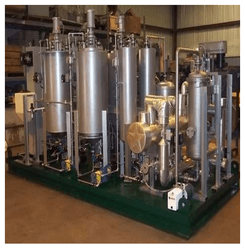Ceramic Corrosion Resistance to Sulfuric Acid
Extensive literature, published during recent years, identifies three general methods of fine-particle preparation: (1) solution techniques, (2) vapor-phase techniques, and (3) salt decomposition techniques. Solution techniques, also referred to as “chemical” preparation, offer the advantages of ease of preparation, good control of composition, and homogeneity. Among the solution techniques a number of terms, such as […]
How to Precipitate Mercury from Gold Silver Cyanide Leach
The discovery of low-grade gold-silver deposits in the United States has resulted in construction of several cyanide-leach carbon-in-pulp (CIP) milling facilities. Gold and/or silver ores typically contain other metals such as mercury and a variety of base metals. Of all the metals most likely present, mercury presents the most serious problem. Typically, 10 to 30 […]
How to Find Old Abandoned Mines
Abandoned mines are a recurring problem for today’s mining industry. In coal, metal, and nonmetal mining they pose a safety hazard if current workings intercept them; and if they are circumvented, large amounts of recoverable resources may be unnecessarily left in the ground. The problem of delineating the boundaries of these old mines is multifaceted. […]
Dredging Safety
In the 1940’s, we visited hydraulic and dredge mining operations in Alaska and California. He also reviewed 10 yr of accident data pertinent to such mining in the United States. The data, covering the period 1933 to 1942, included those related to 36 fatalities and 3,700 injuries in dredge mining. It is generally assumed that […]
Clay Dewatering – Settling – Thickening
The Florida phosphate industry currently produces more than 80% of the total U.S. supply of phosphate rock. The production of this critical mineral is accompanied by the generation of large quantities of dilute phosphatic clays. The disposal of these phosphatic clays has been a problem to the Florida phosphate Industry since the introduction of large-scale […]
Using Wetlands for Treatment of Mine Water
Acid mine drainage is one of the most persistent industrial pollution problems in the United States. Over 5,000 miles of our country’s streams and rivers still fail to meet water quality standards due to acid mine water that originates primarily in abandoned mined lands (Kim et al., 1982). Less than 10 percent of this total […]
Acid Activated Clay
Acid-activated clays are produced almost exclusively from southern or nonswelling bentonites by treatment with various mineral acids. When used for their ability to decolorize or “bleach” color pigments from vegetable and petroleum oils, they are called bleaching clays or bleaching earths. Although sometimes confused with fuller’s earths, which are also sometimes called bleaching clays (Table […]
Atmospheric Elution Process
Acid-washed carbon is loaded into the top of the column from a feed vessel and allowed to rill into the feed hopper. The carbon flow from the feed vessel is automatically choked and will only feed as carbon is withdrawn from the base of the column. There is sufficient surge capacity in the feed hopper […]
Solvent Extraction & Electrowinning Operating Costs

It is fairly easy to separate the capital cost for SX from that for EW. For this reason one might choose to categorize the operating costs in the same way. However, because of the way SX-EW plants are designed and operated and the manner in which costs are allocated this can be a difficult task. […]
Gold Recovery from Molybdenum Concentrate by Cyanidation
Here we describe a cyanide leaching-carbon adsorption plant designed to recover the gold from the molybdenum concentrate. Process Design: The molybdenum concentrate assays typically, 45 percent molybdenum, less than 1 percent copper (chalcopyrite) and 3.5-5.0 percent iron (chalcopyrite-pyrite). Gold and silver average 8 and 40 ppm respectively which at an average molybdenum concentrate production of 10 […]
